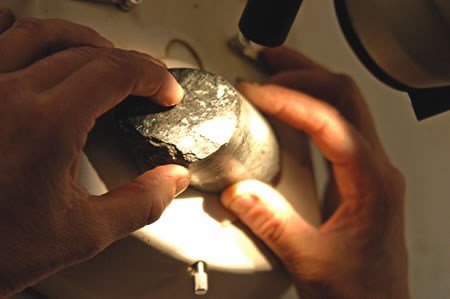After a year’s worth of preparation, Dianor Resources is gearing up to spend $30 million this fall to try and see just how much sparkle sits on their Wawa-area diamond project.
If approved, Dianor will kick off an 18-month bulk sampling program to help identify the economic potential of their Leadbetter Project, located 12 kilometres northeast of Wawa.
Prepared by consultants from Sudbury, Wawa, Montreal and Val d’0Or over the last twelve months, Dianor’s mine closure plans have been submitted to the Ministry of Northern Development and Mines (MNDM).
“This will give us our first good look at the potential economics of the diamond project out there,” says John Ryder, president and CEO of Dianor. “Mainly, it’s to get a valuation of the diamonds, but there’s also room to see other minerals in there that may be worth looking at.”
The bulk sampling will result in the extraction of 34,000 tonnes of material from Leadbetter in the hopes of producing from 7,000 to 13,000 carats of diamonds. This will allow for a better understanding of their economic potential, and give a stronger idea of where future efforts should be focused.
While the exact starting date is at the mercy of the approvals process, other factors include the purchase and establishment of related equipment. The sheer volume of rock being extracted on a daily basis will require the establishment of a 20-tonne-per-hour processing plant. This will involve the use of crushers, X-ray sorters, and dense media separation circuits.
As gold, rubies and sapphires are also present in the rock, adjustments will be made to the standard circuit to determine their recovery potential. This will also help to see what potential they may play in the project’s economic potential.
The excavation will be carried out on two separate areas of the Leadbetter property, both being dug out of the side of a hill at 15-degree slopes. One 400-metre tunnel will see the extraction of 19,000 tonnes of material from the northern end of the property; a 300-metre tunnel will pull out the remaining 15,000 tonnes from the central portion of the site.
In the meantime, Ryder is pushing forward with further exploration on other areas of the property, with a 6,000-metre infill drill program planned for later in the year.
Another source of encouragement for Dianor is just three kilometres away from Leadbetter: the Mori Joint Venture where Dianor has a 30 per cent stake.
Metalex Ventures Ltd., the operator, has a 30 per cent stake, while a private company holds the remainder.
The Mori project is part of the Leadbetter body of rocks, and in recent months turned up 5,216 diamonds across 13 drill holes. The 10 largest were more than 0.85 mm, with the largest being 1.32 mm, and all 10 were coloured diamonds.
In fact, 52 per cent of the recovered total were coloured, including brown, grey, yellow, green, orange, purple, amber, black and even pink.
Not only do these types of stones typically sell for 20 times more than typical diamonds, Ryder says there is no other place in North America that features this kind of range of colours.
Ryder’s other projects are giving him considerable hope for the future, including the company’s Killala property in the Marathon area. The collection and processing of a 1.2-kilogram surface sample resulted in 66 diamonds which weighed a total of 0.23 carats, with the largest one being 0.042 carats.
Ryder says the time is ripe for the company to truly shine, especially given the strength of the diamond market. Prices have risen 24 per cent thus far this year, with some expecting that to rise as high as 40 per cent.
He’s also encouraged by recent news that Rio Tinto plc and the Harry Winston Diamond Corporation have invested $50 million to recover very small diamonds at their Diavik diamond mine in the Northwest Territories. This high-profile sign of confidence in diminutive diamonds should help Dianor with efforts to raise funds for Leadbetter.
“This is the kind of project that’s really suited for the current economic market.”
Since April 2005, Dianor has completed 45 kilometres of drilling, 106 surface samples at 6 tonnes apiece and four 70-tonne samples, all at a cost of $17 million. Ryder attributes this low cost to a variety of factors, including the project’s accessibility by road and its proximity to Wawa, a town with mining experience.
As the findings are essentially on surface, no overburden has to be dealt with, making the project more economic at a time where diamond exploration costs are rising.



.jpeg;w=120;h=80;mode=crop)
